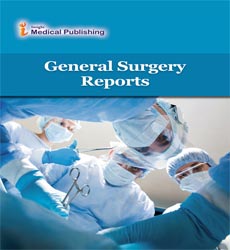Postoperative Complications in General Surgery: Risk Factors and Prevention
*Corresponding author:
Hafiz Irham,
Department of Public Health Sciences and Pediatrics, University of Turin, 10126 Turin, Italy,
E-mail: Irhan.haf@uniroma1.it
Received date: February 03, 2025, Manuscript No. ipgsr-25-20676; Editor assigned date: February 05, 2025, PreQC No. ipgsr-25-20676 (PQ); Reviewed date: February 10, 2025, QC No. ipgsr-25-20676; Revised date: February 17, 2025, Manuscript No. ipgsr-25-20676 (R); Published date: February 24, 2025
Citation: Irham H (2025) Postoperative Complications in General Surgery: Risk Factors and Prevention. Gen Surg Rep Vol.09.1:175.
Introduction
Postoperative complications represent a significant concern in general surgery, impacting patient outcomes, hospital stay, healthcare costs, and overall quality of life. Despite advances in surgical techniques, anesthesia, and perioperative care, complications remain an unavoidable aspect of surgical practice. These complications can range from minor issues, such as superficial wound infections, to life-threatening events, including sepsis, pulmonary embolism, or multi-organ failure. Understanding the risk factors that predispose patients to postoperative complications and implementing effective preventive strategies is essential to improving surgical safety and enhancing recovery [1]. The complexity of postoperative complications arises from a combination of patient-related factors, procedure-specific characteristics, and systemic healthcare considerations.
Patient comorbidities, age, nutritional status, and functional reserve significantly influence susceptibility to complications. The nature of the surgical procedure, duration of operation, blood loss, and invasiveness of the technique further affect outcomes. Additionally, perioperative management, including anesthesia protocols, infection control measures, and postoperative monitoring, plays a critical role in mitigating adverse events. By systematically identifying risk factors and implementing evidence-based preventive measures, surgeons can optimize clinical outcomes and reduce morbidity and mortality. This article provides a comprehensive overview of postoperative complications in general surgery, highlighting key risk factors, common complications, and preventive strategies. By examining the underlying mechanisms and clinical evidence, healthcare providers can adopt a proactive approach to minimize postoperative adverse events, improve patient safety, and promote efficient recovery.
Description
Postoperative complications are broadly classified into surgical and medical complications. Surgical complications primarily arise from the operative procedure itself and include wound infection, hematoma, seroma, anastomotic leakage, bowel injury, and hemorrhage. Medical complications encompass systemic events such as cardiovascular, pulmonary, renal, and thromboembolic issues, often influenced by patient comorbidities and perioperative management. Both categories can interact, with surgical complications precipitating systemic effects and vice versa [2]. Wound infection remains one of the most common postoperative complications in general surgery, contributing to increased morbidity, prolonged hospital stay, and higher healthcare costs. Risk factors for surgical site infections include advanced age, obesity, diabetes, immunosuppression, malnutrition, prolonged operative time, and contamination of the surgical field. Evidence-based preventive measures include appropriate perioperative antibiotic prophylaxis, strict aseptic technique, meticulous tissue handling, and proper wound closure. Additionally, optimizing patient health preoperatively through glycemic control, nutritional supplementation, and smoking cessation significantly reduces the incidence of wound complications.
Anastomotic leakage is a serious complication in gastrointestinal surgery, associated with significant morbidity and mortality. Risk factors include poor tissue perfusion, technical errors during anastomosis, preexisting comorbidities such as diabetes or malnutrition, and emergency surgery. Strategies to minimize leakage involve careful surgical technique, assessment of tissue vascularity, tension-free anastomosis, and intraoperative testing for leaks. Enhanced recovery protocols and early postoperative monitoring are essential for early detection and prompt management of leakage, thereby reducing systemic complications such as sepsis and multi-organ dysfunction. Hemorrhage, both intraoperative and postoperative, poses a critical risk in general surgery [1].
Preexisting coagulopathies, anticoagulant therapy, vascular anomalies, and extensive surgical dissection contribute to bleeding complications. Preventive strategies include thorough preoperative evaluation of coagulation status, meticulous hemostasis during surgery, and postoperative monitoring with timely intervention for any bleeding events. Blood conservation techniques, judicious use of transfusions, and minimally invasive approaches also contribute to reduced hemorrhagic complications.
Medical complications, including cardiovascular and pulmonary events, significantly impact postoperative morbidity and mortality. Cardiovascular complications such as myocardial infarction, arrhythmias, and heart failure are influenced by preexisting conditions, age, intraoperative hemodynamic instability, and fluid management. Pulmonary complications, including pneumonia, atelectasis, and respiratory failure, are common following major abdominal surgery and are exacerbated by prolonged immobility, smoking, chronic obstructive pulmonary disease, and general anesthesia. Preventive measures include preoperative risk assessment, optimization of comorbidities, perioperative cardiopulmonary monitoring, early mobilization, and implementation of pulmonary hygiene protocols, including incentive spirometry and physiotherapy [2].
Conclusion
Postoperative complications in general surgery remain a significant challenge, influenced by patient-related, procedure-specific, and systemic factors. Surgical site infections, anastomotic leakage, hemorrhage, thromboembolic events, and cardiopulmonary complications are among the most common adverse outcomes, each associated with specific risk factors and preventive strategies. Minimally invasive surgical techniques, meticulous operative technique, preoperative optimization, adherence to evidence-based protocols, and vigilant postoperative monitoring collectively contribute to reducing complication rates and improving patient outcomes.
Individualized risk assessment and patient-centered care are essential in tailoring preventive strategies to each patientâ??s unique profile. Multidisciplinary collaboration, integration of technological innovations, and adherence to clinical guidelines enhance the quality and safety of surgical care. Through proactive measures, evidence-based interventions, and comprehensive postoperative management, surgeons can minimize adverse events, promote faster recovery, and optimize long-term health outcomes for patients undergoing general surgical procedures.
Acknowledgement
None.
Conflict of Interest
None.
Reference
- Palanivelu C, Rangarajan M, Senthilkumar R, Madankumar MV (2007) Laparoscopic management of symptomatic multiple hepatic cysts: a combination of deroofing and radical excision. JSLS 11: 466-469.
- Tan YM, Ooi LL, Soo KC, Mack PO (2002) Does laparoscopic fenestration provide long-term alleviation for symptomatic cystic disease of the liver?. ANZ J Surg 72: 743-745.
Open Access Journals
- Aquaculture & Veterinary Science
- Chemistry & Chemical Sciences
- Clinical Sciences
- Engineering
- General Science
- Genetics & Molecular Biology
- Health Care & Nursing
- Immunology & Microbiology
- Materials Science
- Mathematics & Physics
- Medical Sciences
- Neurology & Psychiatry
- Oncology & Cancer Science
- Pharmaceutical Sciences
